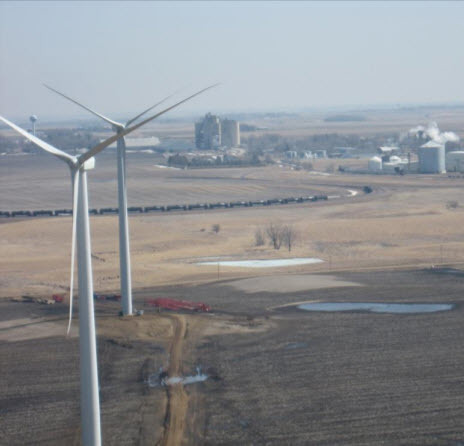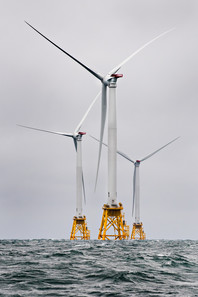 In This Issue
Continue to follow the Wind Energy Technologies Office for the latest news, events, and updates.
News
Sharply reducing carbon emissions is imperative to prevent the worst effects of climate change. Yet even in the power sector—often viewed as the lynchpin to economy-wide decarbonization, and where low-carbon solutions are increasingly plentiful and cost effective—the pace and scale of the required transformation can be daunting.

A review of historical trends, however, shows the progress the power sector has already made in reducing emissions. Fifteen years ago, many business-as-usual projections, such as in the Energy Information Administration’s 2005 Annual Energy Outlook, anticipated that annual carbon dioxide (CO2) emissions from power supply in the United States would reach 3,000 million metric tons (MMT) in the year 2020. In fact, direct power-sector CO2 emissions in 2020 were 1,430 MMT—roughly 50% below the earlier projections. By this metric, in only 15 years the country’s power sector has gone halfway to zero emissions. At the same time, electricity bills are lower, costs to human health from air pollution are lower, climate damages from carbon dioxide emissions are lower, and the number of energy jobs is higher than previously projected.
Some factors that have contributed to this success include broad changes to the economy, energy efficiency, more wind and solar power, continued operations of the nuclear fleet, and switching from coal to gas. Achieving a net zero power sector may be challenging, but if the past is any guide, it suggests that further deep reductions are possible.
|
This study was conducted by Berkeley Lab and funded by the Department of Energy's (DOE’s) Wind Energy Technologies Office. Read the report and the Berkeley Lab press release.
Wind energy has realized accelerated cost reduction over the last five years—both land-based wind and offshore wind. Recent DOE-funded research gathered input from 140 global experts on technology advancement and cost-reduction opportunities. The work follows a similar expert survey conducted in 2015. The DOE-funded 2020 research shows that experts now expect land-based and offshore wind costs to decline ~35–50% by 2050, resulting in costs 50% lower than predicted in 2015. According to the findings, turbine scale is a key driver for cost reduction. Wind turbines are expected to be 2–3 times larger by 2035, with a median of 5.5 MW for land-based turbines and 17 MW for offshore turbines. As costs decline, industry focus will turn to enhancing the value of wind in energy markets, e.g., through hybridization with storage, and to overcoming deployment barriers. If realized, these expected advancements, cost reductions, and value-enhancement measures will enable wind to play a larger role in energy supply and power-sector decarbonization than previously anticipated.
Read the paper on Berkeley Lab’s website or in Nature Energy. Learn more on Berkeley Lab’s webinar, April 29 1pm eastern.

Recently published resources from the National Rural Electric Cooperative Association (NRECA) illuminate how distributed wind projects can be used to benefit rural electric utilities and the communities they power. NRECA’s DOE-funded project, Rural Area Distributed Wind Integration Network Development (RADWIND), aims to understand, address, and reduce the technical risks and market barriers to distributed wind adoption by rural utilities. In the first phase of their project, the RADWIND team has surveyed NRECA membership interests in distributed wind, identified beneficial use cases for distributed wind, and is developing case studies on members’ successful distributed wind projects. The first case study features Iowa Lakes Electric Cooperative, who estimate that their two 10.5-megawatt distributed wind projects will earn well over $300,000 per year for 20 years. The annual revenue from the distributed wind plants benefits the electric co-op and community by helping to keep electricity costs down for members and by improving the local tax base. In addition, several community members profit directly by leasing farmland to the co-op for the turbines.
|
Events
Wind Digital Solutions Summit
Virtual: April 20–21, 2021
Join members of the American Society of Mechanical Engineers at the Wind Digital Solutions Summit, April 20–21. Kelly Speakes-Backman, DOE’s Principal Deputy Assistant Secretary and Acting Assistant Secretary for Energy Efficiency and Renewable Energy, will share how DOE is integrating digital solutions, such as additive manufacturing and machine learning, to enhance existing wind technologies and advance new wind energy solutions. The event will also feature presentations from DOE-funded research laboratories. The summit is an opportunity for participants to learn about the global wind industry as it continues to shift toward digitalization and how digital technology innovations make wind energy more safe, reliable, and accessible through AI (artificial intelligence), big data, robotics, and automation. Find more information on the event website.
International Partnering Forum (IPF) for Offshore Wind
Virtual: IPF Virtual, April 22, May 13, June 17, 2021
IPF Together: August 24–26, 2021, Richmond, VA
The Business Network for Offshore Wind’s International Partnering Forum (IPF) is being held in a multi-part series: virtual and in person. The series will bring together the global offshore wind industry and offer the latest in education, networking, and platforms to help the offshore wind industry grow. IPF Virtual will take place April 22, May 13, and June 17; the main conference, IPF Together, will take place August 24–26 in Richmond, VA. Agenda and registration details are on the IPF website.
Expert Elicitation Survey on Future Wind Energy Costs
Webinar: Thursday, April 29, 2021, 1 p.m.–2 p.m. ET
Hear Berkeley Lab present findings from recent DOE-funded research on land-based and offshore wind energy cost reductions. The DOE-funded 2020 research shows that experts now expect land-based and offshore wind costs to decline ~35–50% by 2050, resulting in costs 50% lower than predicted in 2015. According to the findings, turbine scale is a key driver for cost reduction. Wind turbines are expected to be 2–3 times larger by 2035, with a median of 5.5 MW for land-based turbines and 17 MW for offshore turbines. Register for the webinar on Berkeley Lab’s website.
2021 U.S. Department of Energy Collegiate Wind Competition
Virtual: Student Presentations, June 2–4, and June 7–10, 2021
Virtual: Industry Networking and Awards Ceremony, June 11, 2021
Tune in to the 2021 virtual U.S. Department of Energy Collegiate Wind Competition as multidisciplinary university teams present the culmination of their work in wind energy over the past year. These students were challenged to design and test a model wind turbine, plan and financially analyze a wind plant, and create connections with the wind industry and their local communities. In addition to competition contests, we invite viewers to connect with the 2021 competitors at the virtual industry networking event and cheer on the 2021 winners at the virtual awards ceremony, both on Friday, June 11. Links to the virtual events will be available on the CWC website in the coming weeks.
CLEANPOWER 2021
Virtual: June 7–10, 2021
Tradeshow and Business Development: Dec 7–8, 2021, Salt Lake City, UT
The American Clean Power Association will host CLEANPOWER 2021, which will feature topics related to utility-scale wind, solar, storage, and transmission in a two-part series: virtual and in person. CLEANPOWER will feature a virtual education and collaboration event June 7–10 plus an in-person conference and exhibition December 7–8 in Salt Lake City, UT. The focus for these events is to bring together the different technologies that make up the renewables mix—land-based wind, offshore wind, solar, storage, and transmission—as well as the different segments within the industries: manufacturers, construction firms, owner-operators, utilities, financial firms, and corporate entities. Register for CLEANPOWER 2021 on the event website.
Sandia Blade Workshop
Workshop: October 25–28, 2021, Albuquerque, NM
Sandia National Laboratories issued a “Save the Date” for its 2021 Sandia Blade Workshop, scheduled for October 25–28 in Albuquerque, NM. The workshop convenes wind energy experts from industry, national laboratories, and universities to discuss the research and development of wind turbine blades. For more information, visit Sandia National Laboratories website.
In Case You Missed It

The U.S. Departments of Energy (DOE), Interior, and Commerce today announced a national goal to deploy 30 gigawatts of offshore wind by 2030, which would support 45,000 jobs, generate enough electricity to power over 10 million American homes, and avoid 78 million metric tons of carbon dioxide emissions. This goal builds on President Biden’s Executive Order to address the climate crisis and create American jobs by accelerating the deployment of renewable energy on public lands and waters, including through swift interagency action to advance offshore wind.
Read the DOE Press Release and the White House fact sheet.
|
The Northeast Sea Grant Consortium, in partnership with the U.S. Department of Energy’s Wind Energy Technologies Office and Water Power Technologies Office and NOAA’s Northeast Fisheries Science Center, has announced funding for research to improve understanding of the effects of ocean renewable energy at the intersection of fishing and coastal communities. This funding partnership will support objective, community-focused research on ocean renewable energy – including offshore wind and hydrokinetic current, tidal, and wave energies – from New York Bight to the Gulf of Maine for the benefit of stakeholders. Read the joint agency announcement.
The National Offshore Wind Research and Development Consortium, which is funded in part by DOE, has selected 15 new R&D projects totaling $8 million for offshore wind support structure innovation, supply chain development, electrical systems innovation, and mitigation of use conflicts.
The National Offshore Wind Research and Development Consortium was established in 2018 by DOE and the New York State Energy Research and Development Authority, with each providing $20.5 million to fund high-impact research projects that lower the costs of U.S. offshore wind and support supply chain development. State agencies in Maryland, Virginia, Massachusetts, and Maine have since contributed funding, resulting in a total investment of around $47 million.
See our website for the list of projects. The 15 new projects bring the Consortium’s total funded portfolio to $28 million for 40 projects.
Ready to energize your career and bring your skills and talents to our clean energy mission? Get the latest news on EERE Career Opportunities delivered straight to your inbox. Sign up today!
|